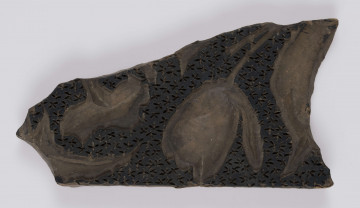
Block for printing on textile
1901 — 1950
National Museum in Lublin
Part of the collection: Fabric printing matrices
Textile printing is a technique that has been known for a very long time and used to be very popular. The primary tools needed for textile printing were stamps (printing blocks). They were made from wood, usually from two boards joined together, where one was covered with a pattern and the other had a hollowed-out handle. The designs of the printing blocks were very diverse. Besides the most popular patterns with floral or geometric motifs or a combination of both, there were also blocks depicting people, animals, vessels and buildings. In use were also stamps „whose pattern printed on fabric was meant to imitate different fabric decoration technique, other than printing (Roman Reinfuss, Polskie druki ludowe na płótnie). Using a printed pattern made it possible to obtain interesting effects, e.g., a ribbon sewn onto the fabric. On printing blocks preserved to this day one can also find imitations of lace knitting. In the ethnographic collection of the National Museum in Szczecin there is a narrow, elongated stamp, which was used for decorating the edges of a fabric. The floral ornament covering it imitates the so-called filet mesh, or a net lace, in which the pattern was made on a base of interwoven and knotted threads. The effect of the lace was achieved by densely sticking small brass pins into the wood, arranged into a fine grid with floral motifs in the background. This stamp was most probably used in one of many local dye workshops operating in the 19th-century Pomerania. It comes from the collection of the Pommersches Landesmuseum Stettin.
Author / creator
Dimensions
cały obiekt: height: 4,2 cm, width: 2,7 cm
Object type
matrix
Creation time / dating
Creation / finding place
Identification number
Location / status

1901 — 1950
National Museum in Lublin

1901 — 1950
National Museum in Lublin

1901 — 1950
National Museum in Lublin
DISCOVER this TOPIC
Castle Museum in Łańcut
DISCOVER this PATH
Educational path